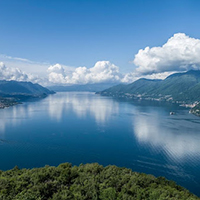Temporal changes in nutrients in a deep oligomictic lake: the role of external loads versus climate change

All claims expressed in this article are solely those of the authors and do not necessarily represent those of their affiliated organizations, or those of the publisher, the editors and the reviewers. Any product that may be evaluated in this article or claim that may be made by its manufacturer is not guaranteed or endorsed by the publisher.
Accepted: 15 November 2021
Authors
The impact of climate change on stratification and mixing patterns has important effects on nutrient availability and plankton dynamics in deep lakes. We demonstrate this in a long-term study of Lake Maggiore, a deep oligomictic lake located in the subalpine lake district in Northern Italy. Studies on physical, chemical and biological features of the lake have been performed continuously since the 1980s. The lake recovered from eutrophication in response to a reduction of catchment nutrient loads and reached a stable oligotrophic status by the end of the 1990s, with average total phosphorus concentrations in the water column around 10 µg L-1. However, both reactive and total phosphorus have slightly increased since 2010, leading to a shift in the lake trophic state towards mesotrophy. The increase in phosphorus has been limited to the hypolimnetic layers, concentrations being fairly stable or decreasing in the epilimnion. Reactive silica also progressively increased in the hypolimnion, while nitrate and total nitrogen concentrations have steadily decreased in both deep and surface layers, especially in the summer period. These changes were assessed in relation to catchment loads, atmospheric deposition and climate-related variations in stratification and mixing patterns and in nutrient retention. Long-term changes in primary production, represented by chlorophyll levels, and biovolume of the main algal groups were also considered. During the eutrophication period and until the 1990s, in-lake phosphorus concentrations were tightly related to external loads; successively, phosphorus and its vertical distribution up the water column became more controlled by internal processes, in particular by stratification and mixing regime. An increase of thermal stability and a reduced frequency and intensity of deep mixing events has fostered oxygen depletion and phosphorus and silica accumulation in the hypolimnion. Another consequence of reduced deep mixing events, has been a reduction in nutrient replenishment of the upper layers at spring mixing. External loads are still the main driver of change for nitrogen compounds: the decrease in the atmospheric load of nitrogen that occurred in the Lake Maggiore area over the last decade, as an effect of reduced nitrogen emissions, has caused decreasing concentration of inorganic nitrogen in the lake. However, the phytoplankton community changes observed might also play a role in nitrogen dynamics, particularly in the nitrate minima observed during summer in recent years.
How to Cite

This work is licensed under a Creative Commons Attribution-NonCommercial 4.0 International License.






